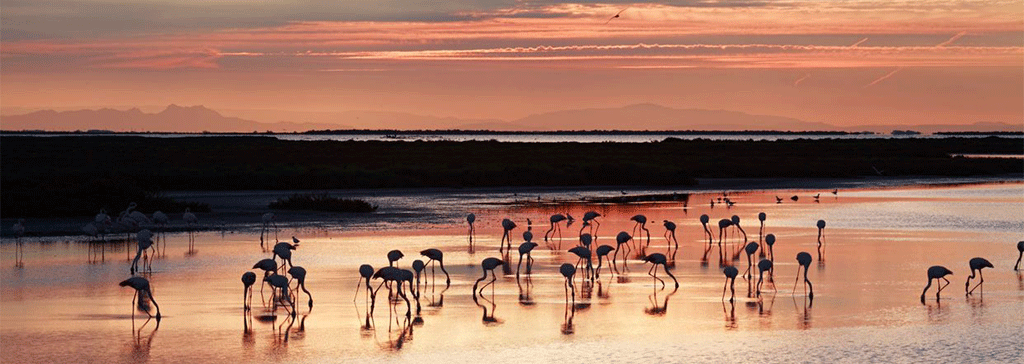
There’s No Place Like the Camargue Delta
Eileen Cho explores this offbeat area of Provence
Most people associate Provence with fields of lavender and sunflowers, apéro snacks made with fresh tomatoes, local olive oil, and the warm Provençal sun. I used to, too.
I’m an American living in Paris, but every July, I head south to Arles, in the southern French region of Provence. Last year, while eating at my favourite restaurant in the city, I discovered French sea salt from nearby Camargue. This salt is one of France’s culinary prides. Intrigued, I decided to explore the region myself. Take advantage of the Interrail France Pass to discover more hotspots!

The Camargue Region
The Camargue region is between the Mediterranean Sea and both mouths of the Rhône river that form a delta – an area rich in nutrients and vegetation. It turns out that the Camargue is the biggest delta in Europe, home to government-protected, rich wetlands, and to more than 400 species of birds – including, unexpectedly, flamingos.

Safari Tours in the Camargue
When I called a local tour company to ask if they offered nature tours, the lady on the phone laughed and told me safari tours were their bestseller. I signed up for a half-day tour.
I was picked up in an open-top jeep by Jean-Michel, the most vivacious and friendly human I'd ever encountered in my years living in France. Jean-Michel had grown up in the region and proudly claimed to be a true Arlésien, and also a "gardien" – a cowboy specic to the Camargue. The "gardiens" traditionally herd cattle and bulls in the region. There are two types of bull in the Camargue: Spanish bulls for bullghting in Spain and Camargue bulls that are used in the arenas for bull-racing in Provence. Unfortunately, these animals are either used for entertainment or are slaughtered – a harsh, cruel reality.
Jean-Michel passes out maps to our group and explains the cultural, natural and economic importance of the river mouths, while pointing to tiny specks of land dotting the south. These tiny islands are home to hundreds of animals, as well as sansouires (salt ats), étangs (salt water lakes), and marshes that form part of the Camargue Delta.

I instantly regretted only booking the half-day tour. If I had signed up for the full day tour, the tour would have continued to Aigues-Mortes Salt Marsh, the largest salt marsh in the Mediterranean, where the famous Camargue sea salt is produced.
Once on the bumpy dirt road, we drive through fields where majestic white horses run free. The Camargue horses are indigenous to the area and although they are smaller than most horse species used for farming around the world, they are incredibly strong.
As we near the water of the Parc Naturel Régional de Camargue, Jean-Michel tells us to be as quiet as possible. Far in the distance, we can see specks of pink everywhere in the water – flamingos. Originating from the west Mediterranean, the flamingos have been reproducing on a tiny island in the Camargue since the 1970s. According to our guide, these stunning birds can be found seeking refuge from April until September (however, according to some experts, due to climate change, the migration patterns have shifted).
The wildlife here is strictly protected, so visitors aren’t allowed to get too close. But from afar, wishing I’d packed my binoculars, I see thousands of pinkish-grey dots decorating the marshes. I learned that flamingos have grey feathers that turn pink due to a natural pink dye found in their diet.
The Sleepy Beach Town of Saintes-Maries-de-la-Mer
After appreciating the natural beauty of the wetlands, the tour continued to Saintes-Maries-de-la-Mer, a sleepy beach town in the Camargue. Here we have free time to explore the town and swim in the sea. After dipping my toes in the sea, I rush to find an ice cream shop to taste the treats that are made with the salts and algae from the region.
Our safari adventure was coming to an end but my fascination with the region was just beginning. After living in France for several years, I grew accustomed to visiting cities and towns to see French architecture, museums, and enjoy the local food produce. I never imagined I’d find an abundance of wildlife right beside fields of lavender and sunflowers.

You might like this as well:
-
![france-paris-metro-bridge-france]() Paris: My Terminus Depot It’s easy to fall in love with Paris. Feel inspired by Iryna’s captivating story about travelling 2000 km by train to Gare de l’Est with Interrail from her home in Ukraine.
Paris: My Terminus Depot It’s easy to fall in love with Paris. Feel inspired by Iryna’s captivating story about travelling 2000 km by train to Gare de l’Est with Interrail from her home in Ukraine. -
![france-provence-camargue-delta-flamingos-beach-sunset]() There’s No Place Like the Camargue Delta Discover the Camargue: Europe’s largest river delta by train with Interrail or Eurail. You’ll find pink flamingos, white horses and black bulls in this beautiful nature reserve.
There’s No Place Like the Camargue Delta Discover the Camargue: Europe’s largest river delta by train with Interrail or Eurail. You’ll find pink flamingos, white horses and black bulls in this beautiful nature reserve.
Change of currency
You cannot change the currency once you have a Pass in your cart. Remove the Pass, and then change the currency on the website header.








